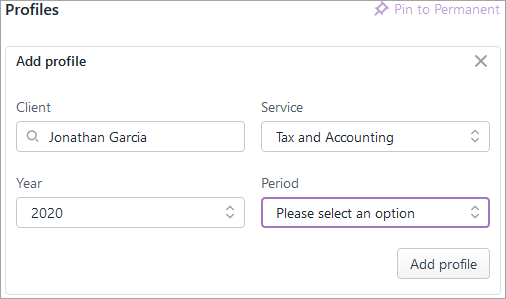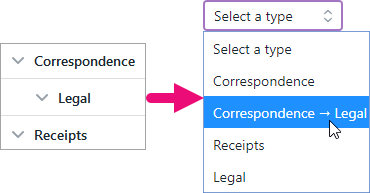You are viewing an old version of this page. View the current version.
Compare with Current View Page History
« Previous Version 25 Next »
https://help.myob.com/wiki/x/QABMAw
How satisfied are you with our online help?*
Just these help pages, not phone support or the product itself
Why did you give this rating?
Anything else you want to tell us about the help?
Do not delete this page - MYOB Practice navigates to it from within the product
As an administrator, configure your document storage settings so that when staff upload or edit documents, they are given options to choose from. These options categorise the documents, and people in your practice can use some of these options to create document profiles. This helps people in your practice quickly find and use the documents whenever they need them.
One of the handiest features of using document storage is the ability to add document profiles.
Imagine you want to find someone among thousands of people but you can't remember their name. They'd be much easier to find if you could narrow down the list of people by hair colour, age range and job title. That's kind of how document profile work! Add identifiers to help categorise your documents.
Profile the documents by client, year, service and period, to organise and quickly find the right documents for different work.

You can use these profile details when searching and filtering.
Service settings
Define service categories that your practice will use to organise documents based on what sort of job it falls under. For example, allow your practice to tag a document as part of Auditing, Tax accounting or Financial planning work.
You can't delete any services, but you can add new ones, or rename existing ones to mark them as obsolete. If you rename a service, the name is updated in the profile settings of any documents that you previously applied the service to.
We don't recommend changing the name of a service to something different to reuse it for something else. Instead, you can mark which service you don't want your practice to use any more by renaming it to have a code like zz at the start of the name.
Period settings
Add the period categories that your practice will use to organise documents. For example, Q1, Q2, Q3, Q4.
Don't use the Period settings to set up years like 2019 and 2020. There's a special Year field your practice can select from when adding a document. You can't configure the years in the settings; they'll update automatically each year.
Document type settings
Add options that your practice can use to categorise documents by what type of document it is. For example, Correspondence or Legal.
When configuring these settings in the Document profiles page, you can add a top-level or child-level type. When your someone in your practice adds a document in the Documents page, they can choose from the top-level type or top-level and child-level type together. For example, Correspondence or Correspondence > Legal.
When configuring the type settings, you see child-level types in a hierarchical structure, but when selecting a type for a document you're uploading, the top-level and child-level types are displayed together.

- As an administrator, on the left of MYOB Practice, click Settings and click Document profiles.
- Click the edit icon (
 ) to the right of the section you want to configure.
) to the right of the section you want to configure.
- Service settings—Enter the document category details relevant for your practice in the Add new setting field, and click Save.
- Period settings—Enter the document category details relevant for your practice in the Add new setting field, and click Save.
- Document type settings:
- To configure a top-level type, click Add a document type, enter the details and click Save.
- To configure a child-level type:
- Click the ellipsis icon (
 ) to the right of top-level document type and click Add child.
) to the right of top-level document type and click Add child. - Enter the details and click Save.
- Click the ellipsis icon (
If you want to Deactivate or Activate a type, click the ellipsis icon (
 ) to the right of top-level document type and click the relevant option.
) to the right of top-level document type and click the relevant option.To see deactivated document types, select Include inactive.

 Yes
Yes
 No
No
 Thanks for your feedback.
Thanks for your feedback.